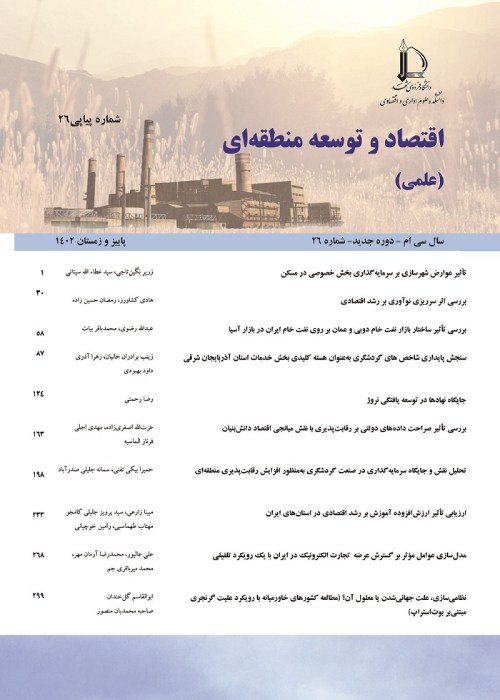The Evaluation of Development Degree in Cities of Khuzestan in terms of Health Care Indicators in2008 and 2013
Author(s):
Abstract:
Introduction
Regional inequality on social and economic grounds is one of the important obstacle in economic development. Thus, one of the main issues for policy making and planning in designing a comprehensive social and economic plan is the balanced development in different regions. The recognition of each region situation in relation to other cases is a necessary factor in decreasing inequalities and the optimal allocation of financial and physical resources to different regions and cities. This paper aims to study the development level in the cities of Khuzestan based on the health care indicators using numerical taxonomy. In this study, 36 health indicators are used to determine and compare the degree of development in the cities of Khuzestan in 2008 and 2013.Theoretical Framework
Health is one of the forms of human capital that can affect the economic performance for the individuals at the macro level. Usually the healthier people produce more, because due to the mental, emotional and physical aspects, they use technology and tools better and more efficient than others (Currie & Madrian,1999) Bleaky believes that health, has a positive effect on the educational achievements. Similarly, the higher extent of healthy, increases the efficiency of the trained manpower (Lotfalipour Fallahi, & Borji, 2011). The effect of health on the labor supply is ambiguous. On the one hand, healthier people have higher productivity and thus the higher wages. The increase in income, leads to greater incentives to supply more labor (the substitution effect). On the other hand, the increase in income may motivate more leisure and may reduce the labor supply, accordingly(the income effect).If the income effect dominates the substitution effect, the economic growth will reduce (Suhrcke et al., 2005).
Methodology
The method of this study is descriptive and analytical while using the numerical taxonomy technique. the geographic scope of the study is the cities of Khuzestan in Iran. the statistical and the data collection techniques are the library and the tables of formal reports. The numerical taxonomy technique was first suggested by Anderson in 1763 and later in 1968 was considered by Hellwing as a method for ranking and determining the development degree of different nations. This is an efficient method for the ranking, classification, and the comparison of countries and different areas taking their development degree into account along with dividing a certain set into relatively heterogeneous (Bidabadi,1983) .The performance steps are as follows: 1. The constitution of data matrix and the calculation of the average and the standard deviation of every column2. The constitution of standards matrix for the elimination of different units and their replacement with a single unit
3. The calculation of composite distances between areas
4. Determination of the homogeneous areas
5. Determining the model or paradigm of areas and grading the development level of areas
. The setting consisted of 20 cities in .Khuzestan The status of these cities was investigated using 36 indicators of health care in terms of the level of development and accessibility by the numerical taxonomy technique in 2018 and 2013. The indicators were selected based on the literature review.
Results And Discussion
The results show that based on the health care indicators, in 2008, the cities of Behbahan and Ramshir, with the coefficients development degree of 0/5885 and 1/0083 were the most developed and the most undeveloped cities respectively while in 2013, the cities of Behbahan and Mahshahr¡ with the coefficients development degree of 0/7235 and 0/9742, were the most developed and the most undeveloped cities accordingly. Also, according to the results in 2008 , Behbahan, Ramhormoz, Ahvaz, Abadan, Shooshtar, Dashte Azadegan, and Baghmalek were above the development border (0/8157) while, Andimeshk, Hendijan, Mahshahr, Dezful, Masjedsolaiman, Shoosh, Omidieh. Khorramshahr, Shadegan, Izeh, Gotvand and Ramshir were below this line. In 2013, Behbahan, Lali, Ramhormoz, Baghmalek , Dashte Azadegan, Ahvaz, Masjeds Solaiman, Hendijan, Dezful, Shooshtar and Andimeshk were above the development border (0/8557) and Omidieh ,Ramshir, Abadan,Gotvand, Shoosh, Izeh, Khorramshahr, , Shadegan and Mahshahr were below the development border. Besides the results show the decrease of inequality between 2008 and 2013.Suggestions: 1-According to the condition of cities of Omidiyeh, Abadan, Gotvand, Shush, Ize, Khoramshahr, Shadegan and Mahshahr in 2013, it is necessary that theauthorities bring balance to the cities of Khuzestan regarding the allocation of health care facilities, especially in Mahshahr that which is the most deprived city in 2013.
2-Since the cities of Izeh, Mahshahr, Khoramshahr, Shadegan, Shush and Hendijan , were undeveloped in both years and got relatively worse in 2013, the policies of the allocation of health facilities in Khuzestan, needs to be modified. to avoide a prolonged and more backwardness of these cities
3-Khoramshahr has suffered from the most damage during the war, in addition to being in the undeveloped group in both years, 2008 and 2013, due to the social and political, reasons and values, thus it is necessary that the authorities pay special attention to the allocation of health facilities to this city.
Keywords:
Language:
Persian
Published:
Journal of Economy and Regional Development, Volume:23 Issue: 11, 2016
Pages:
146 to 166
https://magiran.com/p1662032
دانلود و مطالعه متن این مقاله با یکی از روشهای زیر امکان پذیر است:
اشتراک شخصی
با عضویت و پرداخت آنلاین حق اشتراک یکساله به مبلغ 1,390,000ريال میتوانید 70 عنوان مطلب دانلود کنید!
اشتراک سازمانی
به کتابخانه دانشگاه یا محل کار خود پیشنهاد کنید تا اشتراک سازمانی این پایگاه را برای دسترسی نامحدود همه کاربران به متن مطالب تهیه نمایند!
توجه!
- حق عضویت دریافتی صرف حمایت از نشریات عضو و نگهداری، تکمیل و توسعه مگیران میشود.
- پرداخت حق اشتراک و دانلود مقالات اجازه بازنشر آن در سایر رسانههای چاپی و دیجیتال را به کاربر نمیدهد.
In order to view content subscription is required
Personal subscription
Subscribe magiran.com for 70 € euros via PayPal and download 70 articles during a year.
Organization subscription
Please contact us to subscribe your university or library for unlimited access!


